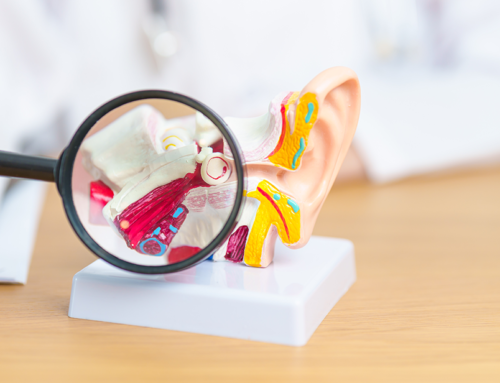When are hearing implants a better solution than hearing aids?
The results with hearing implants and with conventional hearing aids are constantly improving and the limits of use of these different systems are in a constant change.

“Approximately 19 percent of the population suffers from hearing loss that requires treatment,” explains Dr. Thomas Keintzel, primary physician of the ENT department at Klinikum Wels-Grieskirchen. “Hearing aid treatment is still the gold standard here.” Conventional hearing aids amplify sound – depending on pitch and volume – so that the user can perceive it better. But, users should not stop there: “In addition to device support, training has established itself as an essential factor for success.”
However, there are some medical conditions that make the successful use of conventional hearing aids difficult or impossible. For example, a narrowed or repeatedly inflamed ear canal, ossifications in the middle ear or, the loss of the middle ear bones. In some cases, a surgery can help, but 75 percent of all problems require support of a hearing device, states Prim. Keintzel. “However, the use of bone conduction and active middle ear implants has established itself as a valuable alternative to conventional hearing aid fitting.”
When amplification alone is not enough
From an audiological point of view, conventional hearing aids reach their limits when the inner ear is severly damaged. In addition to converting sound vibrations into nerve signals, the inner ear has a function that is almost equivalent to a “preamplifyer”. This is referred to as a compression of the inner ear. In case of sensineural hearing loss, this ability is progressively lost. That is why hearing aids have to amplify soft sounds more than loud ones.
This compression loss of the hearing impaired ear causes a “dynamic reduction”. The difference between the softest sound (which is bearly heard) and the loudest sound (treshhold of pain) becomes smaller. As a results, the contrast between different acoustic signals is also lost: the user can still hear everything with amplification, but certain sounds, speech understanding and conversations become increasingly exhausting despite the hearing aid.
The impaired ear also experiences changes in temporal resolutions (so-called “Auditory masking”), which is happening when predominant sound conceals a softer one. All these effects together mean that from around 50 decibels of hearing loss, speech in noisy environment becomes less and less clear, even with hearing aids.[1]
Modern technologies in conventional hearing aids help
Conventional hearing aids work with various tricks to improve acoustic contrast, and the focus is always on understanding speech. Frequency filters are used to muffle pitches that are not essential for speech undesanding or potentially contain a lot of background noise. Noise cancellation examines each pitch segment for speech signals and amplifies or mutes it accordingly. Directional microphone systems process sounds from the assumed direction of the interlocutor. All these functions are also integrated into audio processors of hearing implants.
The constantly improving speech enhancement technologies enable even users with severly impaired inner ear function to understand speech with their hearing aids. At some point, even current top hearing aids reach their limits. Prim. Keinzel has an advice for the patients that don´t feel better anymore: “In that case, direct electrical stimulation through a cochlear implant can be used to improve speech understanding.”
Understanding speech is key!
“In addition to the continuous technical improvement of both hearing aids and hearing implants, the boundaries of indication have also shifted,” describes Prim. Keintzel. If speech understanding, communication and good quality of life is possible with hearing aids, there is little justification for a surgery. In addition, hearing with a hearing implant (or CI) requires a practice phase: the central auditory system must learn to convert the technically generated signals accordingly.
“Essential decision criterion can be speech understanding with a hearing aid.” In general, if speech understanding with well-fitted hearing aids is worse than it would be expected with a CI, implantation is recomended. However, first you need to be sure that the hearing aid is optimally fitted and suitable for the user.
If a CI user still uses hearing aid on the other side, the doctor will advise implantation on the second side, in case hearing aid does not lead to any improvement in speech understanding.
In children, hearing and language development is the decisive factor. “In the case of children born deaf or children who deafened before language acquisition, this decision must take many factors into account, such as child´s stage of development, communicative competences etc.” emphasizes Prim.Keintzel. “In any case, for children born unilaterally deaf, parents should know the limitations of unilateral hearing – reduced speech understanding in noisy environment, no directional hearing, and all that during the sensitive phase of language acquisition.”
What to expect from a cochlear implant
A CI bypasses the defects in the inner ear and directly stimulates the neural structure of the hearing organ. The center of hearing has to learn to interpret these artificial signals, which is why the user needs a period of rehabilitation and practice. At Austrian ENT Congress in 2021, Prim.Keintzel demonstrated success of cochlear implantation. [2]After one year of CI activation, three quarters of all users understand just as well as a typical hearing impaired persons with a hearing loss of 50 decibels. “Thus, the loss of speech understanding which can be expected from CI fitting is no greater than in a moderate hearing loss,” and this is also the result for persons who were previously completely deaf.
At the same event, Prof. Dr. Dr. Ulrich Hoppe, senior physician at the Erlangen ENT University Hospital, showed a comparison of speech understanding between CI and hearing aid users. The majority of CI users understand speech in noisy environments the same as patients with 25 to 50 decibels of hearing loss with their hearing aids. In fact, all CI users understand better than a typical hearing aid users with a hearing loss of 65 decibels.
For a CI candidate, thorough consideration is always important, but so is a prompt decision. The experienced ENT specialist Keintzel explains why: “Early cochlear implantation leads to shorter rehabilitation times and is associated with better performance and a significant improvement in quality of life.”
Further audiological information and detailed criteria on the subject in: Keintzel T, Limits of conventional hearing aid provision, Jatros Pneumologie & HNO, Universimed-Verlag, 01/2022, pp34-36.
[1] Wardegna et al, 2015
[2] Daten nach Reichell 2015, aus: Kießling et al; Versorgung mit Hörgeräten und Hörimplantaten; Thieme-Verlag 2018; ISBN 978-3-13-240200-3






